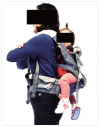Effect of lower limb kinetic on carrying infant by hip seat carrier during high heel gait
- PMID: 30656175
- PMCID: PMC6323350
- DOI: 10.12965/jer.1836376.188
Effect of lower limb kinetic on carrying infant by hip seat carrier during high heel gait
Abstract
While common characteristics between wearing of high heel between carrying an infant elevate height of center of gravity, it is not known what interaction effect influence to leg stiffness. The aim of the study is to investigate the effect of carrying infant by hip seat carrier on leg mechanics during high heel gait. Adult female (n=9) and infant (n=9) participated as subjects. Infant was positioned on rear of trunk as of wearing 6 cm of high heel shoe. Change of leg mechanics was analyzed with ground reaction force variables (1st peak vertical force [PVF], 2nd PVF, center of pressure [medial-lateral, anterior-posterior]), extrapolated center of mass (XCoM) theta, and leg stiffness. While carrying infant with wearing of high heel more increased 1st PVF, 2nd PVF, and leg stiffness than normal gait, and more decreased medial-lateral center of pressure and XCoM theta. High heel and carrying infant showed potential transformation of posture for securement of stability, which related with mechanism to decrease an impulse type. In conclusion, it is suggest that gait for long time in the condition may accumulate fatigue on leg and increase falling injury, so experts of clinics and exercise rehabilitation should understand the mechanism that could recommend guideline for exercise prescription on several problems.
Keywords: Center of pressure; Extrapolated center of mass; High heel shoe; Infant carrying; Leg stiffness; Lower limb kinetic.
Conflict of interest statement
CONFLICT OF INTEREST No potential conflict of interest relevant to this article was reported.
Figures
Similar articles
-
Effect of slipper wearing and carrying positions of infant on dynamic stability and kinetic variable during level walking.J Exerc Rehabil. 2018 Aug 24;14(4):699-703. doi: 10.12965/jer.1836262.131. eCollection 2018 Aug. J Exerc Rehabil. 2018. PMID: 30276196 Free PMC article.
-
Effect on the parameters of the high-heel shoe and transfer time of ground reaction force during level walking.J Exerc Rehabil. 2016 Oct 31;12(5):451-455. doi: 10.12965/jer.1632592.296. eCollection 2016 Oct. J Exerc Rehabil. 2016. PMID: 27807524 Free PMC article.
-
Effect of wearing positions of load on the dynamic balance during gait.J Exerc Rehabil. 2018 Feb 26;14(1):152-155. doi: 10.12965/jer.1835120.560. eCollection 2018 Feb. J Exerc Rehabil. 2018. PMID: 29511667 Free PMC article.
-
Rear foot kinematics when wearing lateral wedge insoles and foot alignment influence the effect of knee adduction moment for medial knee osteoarthritis.Gait Posture. 2017 Sep;57:177-181. doi: 10.1016/j.gaitpost.2017.06.009. Epub 2017 Jun 15. Gait Posture. 2017. PMID: 28649018 Review.
-
Contributions to the understanding of gait control.Dan Med J. 2014 Apr;61(4):B4823. Dan Med J. 2014. PMID: 24814597 Review.
Cited by
-
Effects of high-heeled shoes on lower extremity biomechanics and balance in females: a systematic review and meta-analysis.BMC Public Health. 2023 Apr 20;23(1):726. doi: 10.1186/s12889-023-15641-8. BMC Public Health. 2023. PMID: 37081521 Free PMC article.
-
Decreased Vertical Trunk Inclination Angle and Pelvic Inclination as the Result of Mid-High-Heeled Footwear on Static Posture Parameters in Asymptomatic Young Adult Women.Int J Environ Res Public Health. 2019 Nov 18;16(22):4556. doi: 10.3390/ijerph16224556. Int J Environ Res Public Health. 2019. PMID: 31752144 Free PMC article.
References
-
- Blanchette MG, Brault JR, Powers CM. The influence of heel height on utilized coefficient of friction during walking. Gait Posture. 2011;34:107–110. - PubMed
-
- Chiu MC, Wu HC, Chang LY. Gait speed and gender effects on center of pressure progression during normal walking. Gait Posture. 2013;37:43–48. - PubMed
-
- Cronin NJ. The effects of high heeled shoes on female gait: a review. J Electromyogr Kinesiol. 2014;24:258–263. - PubMed
-
- Csapo R, Maganaris CN, Seynnes OR, Narici MV. On muscle, tendon and high heels. J Exp Biol. 2010;213(Pt 15):2582–2588. - PubMed
-
- Ebbeling CJ, Hamill J, Crussemeyer JA. Lower extremity mechanics and energy cost of walking in high-heeled shoes. J Orthop Sports Phys Ther. 1994;19:190–196. - PubMed
LinkOut - more resources
Full Text Sources



